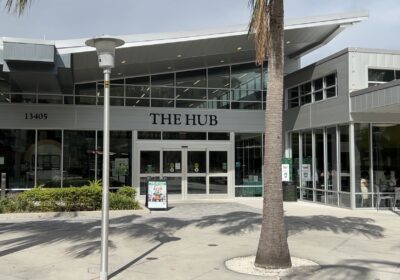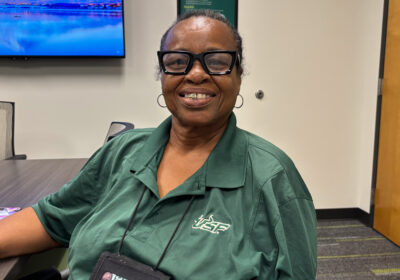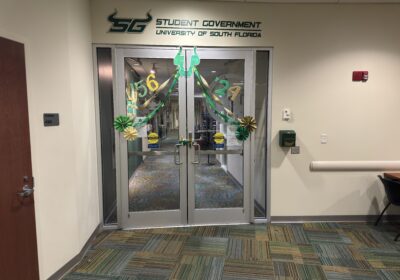Muma tests HyFlex class modality for future semesters

The Muma College of Business has been experimenting with a HyFlex modality of teaching, where students can take a course synchronously online or in the classroom, which will be extended to spring for further evaluation.
The pilot is being held in 55 sections across the college, and it involves 40-45 professors since some are teaching more than one HyFlex course. In a hybrid course, there could be alternate ways of delivery, such as field trips or online meetings, which are scheduled in the syllabus. HyFlex courses have simultaneous dual delivery, online and in person, continuously throughout the semester.
Jacqueline Reck, associate dean for the college, said unless the professor requires students to go in person, students can go back and forth from virtual to face-to-face instruction. They can be in the classroom one week and take the class online the following one without an excuse, according to Reck.
“We’ve actually had students who have started online and then come to class,” Reck said. “It could be because of connectivity issues, or internet issues, or they just decided they wanted to be in class.”
Reck said there isn’t sufficient data available yet regarding the success of the modality, but she received initial surveys from professors who noted strengths and weaknesses with it.
“Some of them like the flexibility, some of them would rather see their students in person so that they could read their students a little better,” Reck said.
Besides the flexibility, Reck said the HyFlex modality allows professors to require students to be in the classroom for specific reasons, such as an exam or a lecture from a guest speaker.
Some professors prefer interacting with all of their students in person, according to Reck. She said they feel some disconnect when they can’t see the students’ body language.
“Even if you’ve got a student in the classroom who doesn’t talk, you can still see them and you can still see how they’re reacting and what they’re doing,” Reck said. “So that kind of bothers the faculty members, that they don’t really know how their students are reacting to the material.”
The HyFlex modality also brings the challenge of teaching and making sure two different audiences, one in person and one online, are understanding the content.
“It’s harder for them to follow both audiences, the face-to-face audience, and then the chat audience, because a lot of times, the students that are online don’t talk, so they don’t really know if those students are getting it until an exam,” Reck said.
“Some of them will write something in the chat, so monitoring that chat and trying to take care of the classroom that’s in front of them at the same time, that can be a little bit more of a challenge.”
Reck said the college wanted to try the modality to make sure students from all campuses have access to classes, even if they are not offered at their home campus.
Professors are broadcasting classes from St. Pete and Sarasota-Manatee to Tampa and vice versa, according to Reck. She said this has been an advantage because of the big footprint Muma has across all campuses.
“That’s why we wanted to try [the modality], to help make sure that we were increasing the accessibility of our courses to our students across the three campuses, particularly for something like an elective that may only be offered in one section so you want to make sure that as many people can participate in it as possible,” Reck said.
For students, the HyFlex modality is particularly beneficial because of the ongoing pandemic, according to Reck.
“I think that it allowed students some flexibility and really some sense of security, many of the students opt in to be online because of concerns for health and safety reasons,” Reck said.
Students haven’t evaluated the modality this far since midterm grades haven’t been posted yet. Reck said it is hard to know how beneficial HyFlex has been for them and how they feel about it until the grades are submitted and performances are evaluated.
The college has decided to extend the pilot for the spring semester as class registration approaches Nov. 1. During the Sept. 29 faculty meeting, Provost Ralph Wilcox said the university would monitor the performance of students under HyFlex classes.
“[HyFlex classes] effectively challenge instructors to deliver dual modality instruction,” Wilcox said. “It’s hard, hard work as those of you who are teaching utilizing a HyFlex modality, understand. So we’re not at this time going to expand beyond the Muma College [of Business].”
At the end of the semester, Reck said the college will do an assessment of the modality although Reck said in teaching there is no final result.
“Innovative education is already working with us on that, we’ll probably go out and do some student surveys and find out. I know some of the faculty have been doing intermittent surveys throughout the semester to try and get a feel for what did the students like, what don’t they like, why are they choosing to attend, why are they choosing not to attend,” Reck said.
“Even with the likes and the dislikes, sometimes the rationale, or the reason for attending or not attending can help us with our decision process.”
The decision to move forward with the HyFlex modality will be made by USF and not only Muma, according to Reck.
“We don’t know exactly how it’s going to go forward in the future,” Reck said. “We see some strengths, we see some weaknesses … but it is definitely a different way than we’ve done it in the past.”







